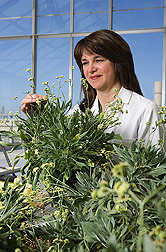This page has been archived and is being provided for reference purposes only. The page is no longer being updated, and therefore, links on the page may be invalid.
Read the magazine story to find out more. |
|
|
Guayule: Is This Desert Shrub a Fuel of the Future?
By Marcia WoodFebruary 20, 2009
Superb natural latex from a desert shrub called guayule (why-YOU-lee) makes high-quality gloves, medical devices, and other in-demand natural rubber products.
But guayule may also prove to be an economical, environmentally friendly source of another valuable resource—energy. That's according to Agricultural Research Service (ARS) chemist Colleen M. McMahan at the agency's Western Regional Research Center in Albany, Calif.
Bioenergy can be made from ground-up guayule stems and branches, left after their white, rubber-rich latex has been removed, McMahan noted. The leftovers—a soft, light brown sawdust-like material called bagasse—provide 8,000 to 9,000 Btu per pound, about the same as charcoal.
McMahan's collaborators include ARS chemist Kevin M. Holtman at the Albany center, who has already made small amounts of ethanol from guayule, and chemical engineer Akwasi Boateng at the ARS Eastern Regional Research Center in Wyndmoor, Pa. Boateng is looking into converting guayule bagasse into bio-oil or synthetic gas.
Guayule offers many biofuel benefits. It isn't a food or feed crop, so using it for energy production won't compete with those uses. Guayule shrubs can be harvested for the first time as early as two years after planting, and are ready to harvest again in about another year and a half.
Guayule's bagasse and latex are available year round. The only other biofuel feedstock available continuously right now is garbage (municipal solid waste).
In addition, guayule thrives in hot, dry ecosystems where many other biofuel crops wouldn't grow well. The hardy shrub requires less fertilizer than other crops currently produced in the desert Southwest. Even though a few herbicides are needed while the plants are getting established, once that happens, there's no need for more—or for chemicals that target harmful insects, fungi, or worms called nematodes.
Read more about this research in the February 2009 issue of Agricultural Research magazine.
ARS is the principal intramural scientific research agency of the U.S. Department of Agriculture.

